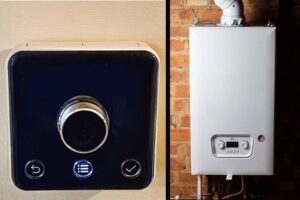Table of Contents
Your home’s outside walls most likely consist of two “skins” separated by about 50 mm. This indicates that they are hollow, which means that they are “cavity walls,” and the space between them can be filled with insulation to keep heat inside.
You can examine the brickwork to see if your house has cavity walls. If the bricks only show their long sides, your house has cavity walls. If the bricks show both long and short lengths, your house has solid walls.
Your heating expenditures can be lowered to the point that cavity wall insulation quickly pays for itself. Furthermore, grants are available to assist with the cost of cavity wall insulation.
Cavity wall insulation can make your home more energy efficient, keeping you warm and saving money.
We will outline the situations in this article that should i get cavity wall insulation for homes in UK.
Check your eco4 eligibility online and get free insulation at your property in the UK.
What is Cavity Wall Insulation?
If you built your house after the 1930s, the outside is probably made up of two walls: an inside wall and an outside wall called a “leaf” or “skin.” This is the cavity wall; there’s a space between these skins! Normally, the hollow has a width of 50–75 mm.
Cavity wall insulation is the process of adding material in the space between the two skins of the wall.
Is my Home Suitable for Cavity Wall Insulation?
In general, cavity wall insulation will be appropriate for your house if:
- The external walls are unfilled cavity walls.
- The brickwork and/or cement are in good shape.
- Your cavity has a minimum width of 35 mm or 50 mm if you have certain types of insulation.
If any of these things happen and there’s no way to fix them, cavity wall insulation shouldn’t be installed if:
- Improper maintenance or structural problems such as wall cracks.
- Evidence of rising or penetrating damp
- Unclean wall connections, dirty cavities, or trash from builders inside the cavity.
- Places that are open to the weather, especially where strong winds and heavy rain can hit the outside walls.
- Overflowing or blocked guttering.
Which type of Insulation is Ideal for Use with Cavity Walls?
Well, there are various different types. Polyurethane foam can be injected into your cavity. Typically, several kinds of fibreglass can be injected into the cavity in different combinations. These are the principal ones; you can also add polystyrene beads into the cavity.
As they’re all genuinely fairly good at what they do, the best one really depends on how well it’s set up. However, I must admit that I would invest my money on the polystyrene beads for the simple reason that they flow. This implies that the polystyrene beads will eventually sink to the bottom of the space if you essentially pour them in from the top. In order to nicely work in insulation beneath window sills, polystyrene is also used underneath certain items.

How is Cavity Wall Insulation Installed?
Most people insulate cavity walls by making a number of small holes in the cement every so often. Each hole should be about 25 mm across, which is about the size of a ten-pence. The insulation material is then pushed into the holes. After the insulation has been poured in, the holes are filled again. As part of the building process, rigid insulation boards are often put into the wall spaces of new homes.
Which Material Should I Use?
Polystyrene “beads” are the material commonly used in cavity wall insulation these days.
Mineral fibre and expanding foam are less common than polystyrene beads because they don’t keep heat in as well and don’t absorb wetness. It’s also easier to blow beads into the hole so they can be put in faster. This is due to the reason that fewer holes need to be drilled into the wall. Because of this, there won’t be as much post-work repairing required, and using scaffolding would have increased project costs.
How Much Money Will I Save?
These estimated numbers, which are based on a gas-heated home, were released by the Energy Saving Trust. The average install cost is unsubsidised. The fuel costs used in the figures are from February 2024.
| Type of House | Typical installation cost | Energy bill savings |
| Detached bungalow | £2,100 | £200/year |
| Mid-terrace house | £1500 | £155/year |
| Purpose built flat | £1,000 | £123/year |
| Detached house | £4,600 | £455/year |
| Semi detached house | £2,700 | £265/year |
Will Cavity Wall Insulation Reduce Noise?
If your noise is passing through the wall itself, then perhaps it can. But noise usually gets through things like windows, roofs, air bricks, doors, and so on. As a result, it might cut down on some noise that travels through a wall, but not by much most of the time.
Will Cavity Wall Insulation Dry Out?
The answer is actually yes. Things used for cavity wall insulation are very good at moving water around and drying out on their own, so it does take a long time. In general, though, it will dry out over time. If you have wet cavity wall insulation, the best thing to do is install some external wall insulation. Especially vapour permeable wall insulation, to warm up the space and let it dry out.
What to do if your Cavity Wall Insulation Isn't Working Properly
If you have issues with your walls after insulation, such as mould and damp, you should first call the company that did the work. Their first visit or study might have made the problem worse, so they should talk to you about it and come back to your house to check. If so, they need to take corrective action to fix the issue and, if necessary, remove the insulation.
You can call CIGA (Cavity Insulation Guarantee Agency) to see if you have a 25-year CIGA Guarantee if the provider won’t help or is no longer in business. If you do, they need to be able to assist in resolving the matter in accordance with the guarantee’s conditions. There may be another promise that is backed by insurance and covers the same things. Check the papers that were used to set up the system. You can obtain a CIGA guarantee if you don’t already have one. CIGA also has a form for reporting illegal acts.
Signs of moisture in a house can often be quite similar. It could be because of bad insulation or not taking enough care of your home, among other things. Unless the problems were caused by bad insulation, work, or materials, they won’t pay to fix them or fix the work that was done. This is true for both the installation company and the guarantee company. If you think your installer is not ready to help you for no reason, you should write them a letter.
Conclusion
People raised a question about should i get cavity wall insulation? Cavity wall insulation is only suggested if you also add external wall insulation. Before winter, the due point needs to be changed from the hollow to the insulation on the outside. This will keep the hollow dry. The leaf on the outside of the wall is also there to keep rain and other wet things from getting to it and coming inside.
Frequently Asked Questions
Actually, it does. Most of the time, the installers notify Building Control, but it is a notifiable procedure if they don’t. Therefore, it’s important that Building Control be informed about it and take part in it.
Generally not. If anything, unless you have insulation on your external walls, it’s more likely to produce wetness. So that’s basically a no.
Generally, it doesn’t. It will need to be replaced in part and put back in if the building is altered and the hollow wall insulation is left out. There’s no reason for it to break down and turn into something else. Therefore, usually not unless it gets lost or disturbed in some way.
One would hope so, but as I already said, that’s only true if you have outdoor wall insulation. If you don’t, the extra moisture that could move through it will cancel out any extra warmth it gives you.








